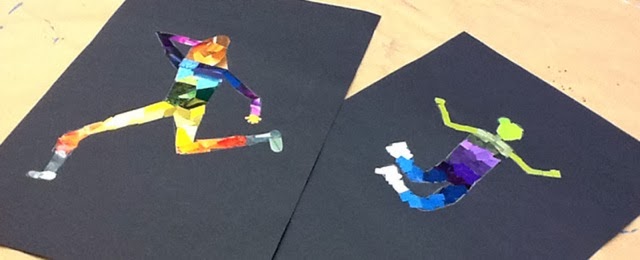To conclude my recycling unit with third grade (which I will post the rest of today) I wanted to do a clothing/fabric recycling project.
I thought my third graders would get a lot out of three dimensional project and enjoy making puppets.
It has taken a lot of patience and lugging around of materials but the kids are psyched and have learned a lot.
Day 1: We began with a tongue depresser and styrofoam ball.
I have very limited clay & model magic. The styrofoam let me use the least amount of clay and kept the head light. The only tools I gave them were a popsicle stick and a small pikey one side/flat on the other stick. The kids rolled a ball with the model magic then flattened it like a tortilla. They wrapped the flat clay around the head and covered a bit of the neck. They PINCHED to pull out the nose.
Then holding the popsicle stick horizontally they wedged open the mouth by wiggling it up and down a little bit and then pinching the corners of the mouth.
Each student stuck on two google eyes and then smooshed the clay over a little to create eyelids and keep the eyes stuck. They could also pinch out two ears and push them back a bit.
No hair was allowed.
Day 2: Each student masking taped a popsicle stick to create arms. Then cut out hands out of manilla colored paper and glue sticked them to the ends of the popsicle sticke.
Each student also received a rectangle piece of white fabric/muslin. They cut it in half and cut out a circle from the middle. Then we put some elmers glue on the tongue depresser and popsicle stick and wrapped some cotton around them for the puppet's "insides". And finally covered the puppet body in the fabric and glued it together.
The conclusion was what my students refer to as the "scary grandpa ghosts" BUT it gave us a good giggle and they truly comprehended the idea of building something from the inside out.
Day 3: HAIR!
We talked a lot about hair... how it grows out of the head, how it covers the back and sides of the head (even on boys), different types of hair, how bangs and ponytails work, etc.
I had a variety of yarns available for the children to use and encouraged them to really experiment with unraveling it, cutting it, etc.
(In my opinion this is one of the most fun parts of the puppet process!)
To glue: I had then dip the top of the head into the puddle of craft and spread it out with a popsicle stick like frosting a cupcake. It worked very well.
Day 4 ( possibly 5 + 6....): Clothes! Oh my!
We are still working this out by the way.
This was a big part of the recycling.
Some of my students brought in clothes to recycle/transform into clothing.
I cut up the garments to show them how much fabric there was.
I pretty much gave the kids a few suggestions for strategies and then let them experiment, plan, and problem solve on their own here.
We are still working out some kinks. But the kids are SO excited about them.
















































